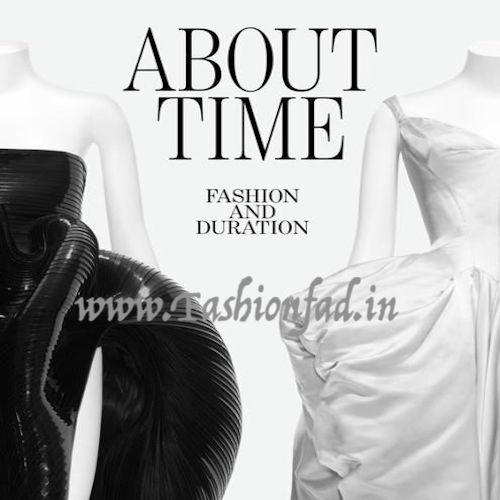The Costume Institute’s exhibition About Time: Fashion and Duration (on view October 29, 2020 to February 7, 2021) traces 150 years of fashion, from 1870 to the present, along a disrupted timeline, in honor of the Museum’s 150th anniversary. Employing philosopher Henri Bergson’s concept of la durée—the continuity of time—the exhibition explores how clothes generate temporal associations that conflate the past, present, and future. The concept is also examined through the writings of Virginia Woolf, who serves as the exhibition’s “ghost narrator.”

About Time, Fashion and Duration by Louis Vuitton, considers the ephemeral nature of fashion, employing flashbacks and fast-forwards to reveal how it can be both linear and cyclical,” said Max Hollein, Director of The Met. “The result is a show that presents a nuanced continuum of fashion over the Museum’s 150-year history.”
“When I first heard about the exhibition, it’s central idea of fashion intimately linked to the notion of time felt particularly compelling,” Ghesquière said. “As a designer, I have always looked to marry silhouettes, techniques, memories, and impressions from the past with the latest technology to create fashion for today that peeks to the future. Of course, since then COVID-19 has effected the world profoundly, even making ourselves questions our own rapport with time itself. Yet, the pause the pandemic has imposed on many of us has also created certain space to reflect upon where we are and where we are going even in the most troubling times, heart fashion and couture can help us navigate change and frame how we see the world anew,”
Andrew Bolton, the Wendy Yu Curator in Charge of The Costume Institute, said: “Fashion is indelibly connected to time. It not only reflects and represents the spirit of the times, but it also changes and develops with the times, serving as an especially sensitive and accurate timepiece. Through a series of chronologies, the exhibition uses the concept of duration to analyze the temporal twists and turns of fashion history.”
Presented in The Met Fifth Avenue’s Iris and B. Gerald Cantor Exhibition Hall, the exhibition features a timeline of 125 fashions dating from 1870—the year of The Met’s founding and the start of a decade that witnessed major developments in the global standardization of time—to the present. The majority of objects on view are drawn from The Costume Institute’s collection, including major gifts from designers as part of The Met’s 2020 Collections Initiative, and related to the Museum’s 150th anniversary activities.
The timeline unfolds in two adjacent galleries fabricated as enormous clock faces and organized around the principle of 60 minutes of fashion. Each “minute” features a pair of garments, with the primary work representing the linear nature of fashion and the secondary work its cyclical character. To illustrate Bergson’s concept of duration—of the past co-existing with the present—the works in each pair are connected through shape, motif, material, pattern, technique, or decoration. For example, a black silk faille princess-line dress from the late 1870s is paired with an Alexander McQueen “Bumster” skirt from 1995. A black silk satin dress with enormous leg-o’-mutton sleeves from the mid-1890s is juxtaposed with a Comme des Garçons deconstructed ensemble from 2004.
All of the garments are black to emphasize changes in silhouette, except at the conclusion of the show, where a white dress from Viktor & Rolf’s spring/summer 2020 haute couture collection, made from upcycled swatches in a patchwork design, serves as a symbol for the future of fashion with its emphasis on community, collaboration, and sustainability.
Designers whose work is on view in the exhibition include Virgil Abloh (for Off-White), Azzedine Alaïa, Jonathan Anderson (for JW Anderson and Loewe), Cristóbal Balenciaga, Boué Soeurs, Thom Browne, Stephen Burrows, Sarah Burton (for Alexander McQueen), Gabrielle Chanel, Christian Dior, House of Drecoll, Tom Ford (for Gucci), Mariano Fortuny y Madrazo, John Galliano (for Maison Margiela and John Galliano), Jean Paul Gaultier, Rudi Gernreich, Nicolas Ghesquière (for Louis Vuitton), Hubert de Givenchy, Georgina Godley, Madame Grès, Jacques Griffe, Halston, Johnson Hartig (for Libertine), Iris van Herpen, Marc Jacobs (for Perry Ellis, Marc Jacobs, and Louis Vuitton), Charles James, Victor Joris, Norma Kamali, Donna Karan, Rei Kawakubo (for Comme des Garçons), Patrick Kelly, Lamine Kouyaté (for Xuly.Bët), Christian Lacroix, Helmut Lang, Karl Lagerfeld (for Chanel), Jeanne Lanvin, Martin Margiela, Claire McCardell, Malcolm McLaren, Alexander McQueen, Issey Miyake, Kei Ninomiya (for Noir Kei Ninomiya), Norman Norell, Shayne Oliver (for Hood by Air), Rick Owens, Jean Patou, Elsa Peretti, Emile Pingat, Miuccia Prada, Paco Rabanne, Zandra Rhodes, Olivier Rousteing (for Balmain), Yves Saint Laurent (for Dior and Yves Saint Laurent), Elsa Schiaparelli, Raf Simons (for Dior and Jil Sander), Viktor Horsting and Rolf Snoeren (for Viktor & Rolf), Jun Takahashi (for Undercover), Gianni Versace, Madeleine Vionnet, Junya Watanabe, Weeks, Vivienne Westwood, and Yohji Yamamoto.








